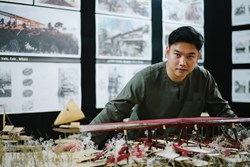The Titan
This essay was Highly Commended in the Open Category of the 2016 Warren Trust Awards for Architectural Writing.
By Diana Noonan
“It was full of prostitutes,” says my mother, sipping coffee from a deep cream cup. “And a madman lived halfway up the street.” She steals a sideways glance through the narrow sash window of my tiny living room. “Or perhaps it was opposite.”
I straighten the hooked rug beneath my feet, smooth the wrinkles in the crocheted throw that covers the tired sofa, and will her to leave.
“Whenever there was a new moon,” she continues, “this old man would scream blue murder and throw bottles from his doorway onto the footpath.” She helps herself to a piece of shortbread. “Titan Street was notorious! A dreadful place.”
My mother knows these things. Eighty years ago she lived just around the corner, in a flat above her parents’ shop. But I have no wish to hear her diminish Titan with her torrid reminiscences for I have fallen hopelessly in love with its most diminutive dwelling – The Robert Lord Cottage. Billed by the trust which administers it as “quite possibly the smallest home in Dunedin, in the city’s smallest street,” the 1909 residence is a retreat for writers like myself in search of solitude, and I am already wishing my six-week stay in it was to be six months.
An hour later, my mother leaves, kicking aside the shards of broken glass spilling from my student neighbours’ rubbish bag, and muttering to herself that “nothing’s changed”. I wave goodbye, sighing with relief as her Nissan weaves its way down Titan tributary and into gushing George Street.
I have left my Catlins home to be here, abandoned quiet bays and amber kelp and tracts of pristine rainforest to fish for inspiration among the beer cans and the dying pizza boxes in this city of literature.
“A squalid street on the edge of Scarfieland” and a historic brick cottage with pale pointings is my temporary home, and I could not be happier. For a little time, this other world is mine and the late, deliciously intriguing playwright Robert Lord my company.
Robert was 30 and had written six successful plays and tucked a Katherine Mansfield Young Writer’s Award under his belt when he made the decision in 1975 to leave New Zealand and base himself in New York. From his apartment on 85th Street West and Broadway he would stroll to Riverside Park to walk his beagle, Becky, or visit his favourite delicatessen, Zabar’s. And for the next 15 years, while the deadly HIV virus gathered momentum and cut a silent swathe through the city’s gay community, he continued to produce plays at an admirable pace, returning briefly to New Zealand in 1987 to take up he Burns Fellowship at the University of Otago.
It was at about this time that Robert began house-hunting in Dunedin and, with limited means with which to purchase something, settled upon 3 Titan Street. A rectangular, singlestoreyed, one-bedroom worker’s cottage with a front door fitted directly to the street, and within a stone’s throw of the university, it could not have been more modest; yet his close friend, Nonnita Rees, remembers Robert, in a state of high excitement, summonsing her to look at it. “He was desperate for a place of his own – and this was it.”
Sometimes, as I sit at the writing desk in Robert’s living room, his mother’s handiwork decorating floor and furniture, and the warmth of the unlit fireplace with its coal insert and kauri mantel behind me, I feel his delight. A writer’s mind is seldom static. Thoughts move at such speed; ideas arrive and vanish almost simultaneously, or linger to converse and meld or pirouette and dance from brain to page. Was it the solidity of this old home, the dependability of its double-brick walls and sturdy ceilings of wide battened timbers, that drew him to it? Or its simplicity – a single passageway off which open three simple rooms? Was it that, in a cottage of such plainness, there was, at times, relief from the complexities of thought?
Cornices and iron hips and wythes and dado panelling – the architecture of this cottage sings more of poetry than plays. In the pocket handkerchief backyard with its outdoor privy and little shed roofed with red corrugated iron, pale narcissi are in bloom and the upturned cups of violet anemone fill with tiny leaves that fall like rain from the kowhai under which Robert’s ashes are buried.
He died in summer, on my birthday. He was 46. Antiretroviral therapy was only in rehearsal. The play opened too late to save him. The funeral service at All Saints Church was, by all accounts, as unsentimental and straightforward as the cottage, the vicar noting simply that Robert had “reached that point in his life where he was not to stay on”.
Friends and family gathered afterwards at 3 Titan Street: Sam Neill, bearded for Jane Campion’s Piano, and former artistic director of Downstage, Sunny Amey, negotiating two broken legs from a recent fall.
If I open the panelled door of the living room where I write, and walk across the squeaking floorboards of the passage to the kitchen, still lined in places with comfortable tongue-and groove, I can hear the tinkle of the mourners’ spoons against their teacups, the soft pop of a cork, the quiet chink of a glass placed with care upon the cold cast-iron plates of the Shacklock Orion.
Death is no reason not to smile and, peering in through the door to Robert’s bathroom, a small group, late back from the church, gathers to admire the vast stainless-steel swimming pool of a bathtub that Robert, at six foot three, installed at a time when it would have taken less than a small mortgage to fill it with hot water. Outside, in the garden, a woman sits cross-legged on the edge of a boxed-brick surround built to hem in a tiny flower bed. Beside her, someone reaches up to tap the faucet of the impossibly high al fresco shower Robert used whenever weather permitted.
Where he could, Robert liked to make changes to the cottage himself, although his sense of the aesthetic at times overrode more important considerations. “He was not a particularly practical person,” recalls actor Karen Elliot. Living in the cottage during a period when Robert was engaged in renovations, she was alarmed by his intentions to use an interior door on the outer north-facing wall.
He felt it suited the building.
Others who knew him echo her sentiments and smile at his work, which I have also come to enjoy: the painted-over wallpaper with its agreeable lumps and bumps, the oddly interesting wardrobe in the bedroom with its twin-opening panels constructed from a kauri door which Robert sawed in half. His height is daily with me as I stand on tiptoe to look into a mirror or reach a light switch in the kitchen, or struggle to pull the shower curtain on a railing out of reach.
From his framed portrait on the living room wall, Robert smiles at my difficulties with gentle humour and bright eyes. His elbow propped on his knee, and his mouth half covered by the fingers of one hand, he may even, on occasion, be laughing.
But he understands what it is to write; to gather and assemble voices, situations, half-remembered conversations; the watercolour wash of phrases, the subtle pastel tones of pace, nuance painted with the lightest brushstroke. At the end of my second week in the cottage, my mother phones to ask if I am bored.
“No,” I reply, “I am writing a book.”
She has been shopping. Pak’n Save was overrun with beneficiaries, the check-out queues long, the car park crowded. She has found a new microwavable pie that promises not to disappoint. She wants to come to visit me again in Titan Street.
I open my mouth to make excuses, but Robert stops me in my tracks.
“It’s all grist to the mill,” he says. “Go on. Invite her over.”
Read this essay and nine others in 10 Stories: Writing About Architecture / 2 available for $15 + postage in the NZIA shop.



